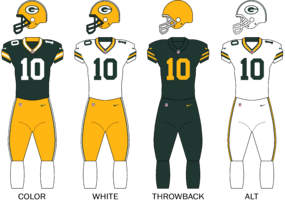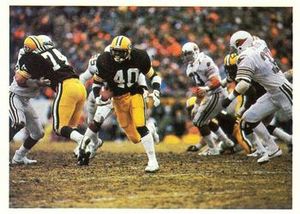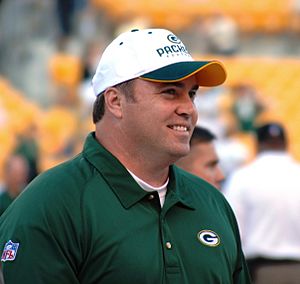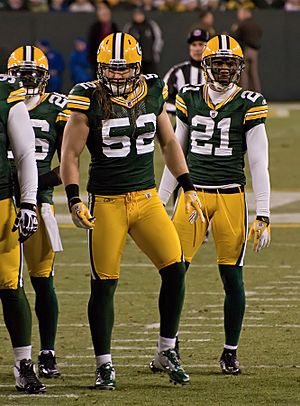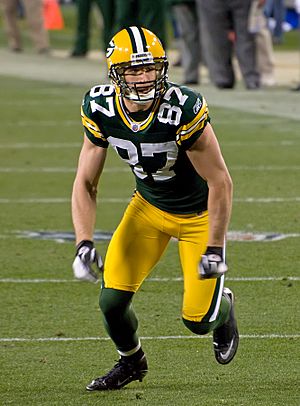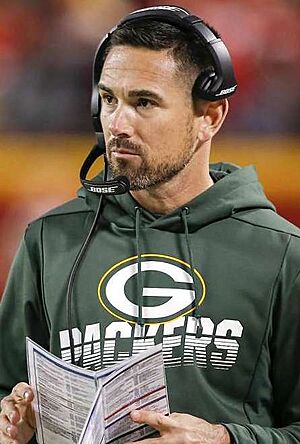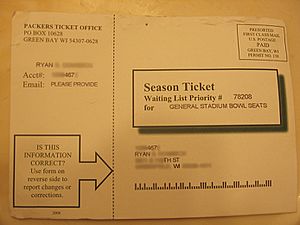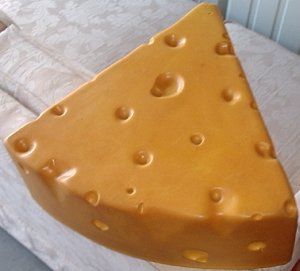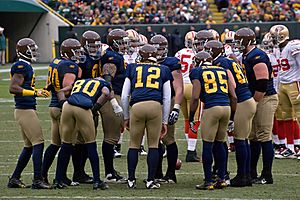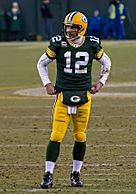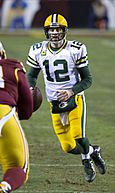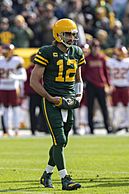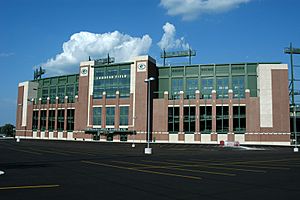Green Bay Packers facts for kids
Quick facts for kids Green Bay Packers |
|||||||||||||
|---|---|---|---|---|---|---|---|---|---|---|---|---|---|
|
|||||||||||||
| Basic info | |||||||||||||
| Established | August 11, 1919 | ||||||||||||
| Stadium | Lambeau Field Green Bay, Wisconsin |
||||||||||||
| Headquartered | Lambeau Field Green Bay, Wisconsin |
||||||||||||
| Colors | Dark green, gold, white |
||||||||||||
| Fight song | "Go! You Packers Go!" | ||||||||||||
| Personnel | |||||||||||||
| Owner(s) | Green Bay Packers, Inc. (537,460 stockholders – governed by a Board of Directors) | ||||||||||||
| Chairman | Ed Policy | ||||||||||||
| CEO | Ed Policy | ||||||||||||
| President | Ed Policy | ||||||||||||
| General manager | Brian Gutekunst | ||||||||||||
| Head coach | Matt LaFleur | ||||||||||||
| Nicknames | |||||||||||||
|
|||||||||||||
| Team history | |||||||||||||
|
|||||||||||||
| Home fields | |||||||||||||
|
|||||||||||||
| League / conference affiliations | |||||||||||||
| Independent (1919–1920) National Football League (1921–present)
|
|||||||||||||
| Championships | |||||||||||||
League championships: 13†
|
|||||||||||||
Conference championships: 9
|
|||||||||||||
| Division championships: 21 | |||||||||||||
| Playoff appearances (37) | |||||||||||||
|
|||||||||||||
| Owner(s) | |||||||||||||
|
|||||||||||||
The Green Bay Packers are a professional American football team from Green Bay, Wisconsin. They play in the National Football League (NFL) as part of the National Football Conference (NFC) North division. The Packers are one of the oldest teams in the NFL, started in 1919. They are also the only major professional sports team in the United States owned by the community, not a single person or company. Since 1957, their home games have been played at Lambeau Field. The Packers hold the record for the most wins in NFL history.
The Packers are the last "small-town team" from the early days of the NFL (1920s and 1930s). Earl "Curly" Lambeau and George Whitney Calhoun founded the team in 1919. They joined the American Professional Football Association (which later became the NFL) in 1921. The team played some home games in Milwaukee until 1995. Even though Green Bay is the smallest city with a major league sports team, Forbes magazine valued the Packers at $2.63 billion in 2019.
The Packers have won 13 league championships, which is the most in NFL history. This includes nine titles before the Super Bowl era and four Super Bowl victories. Under coach Vince Lombardi, the Packers won the first two Super Bowls in 1966 and 1967. After Lombardi retired, the Super Bowl trophy was named the Vince Lombardi Trophy in his honor. The team had some tough years in the 1970s and 1980s. However, things improved after Brett Favre joined in 1992. Since then, the Packers have often done well, making 23 playoff appearances and winning two more Super Bowls: 1996 with coach Mike Holmgren and 2010 with coach Mike McCarthy. The Packers have the most wins (826) and the second-highest winning record (.571) in NFL history, including both regular season and playoff games.
The Packers have strong rivalries with the Chicago Bears, Minnesota Vikings, and Detroit Lions. These teams are all in the NFC North division. The Packers have played over 100 games against each of these teams and have a winning record against all of them. The Bears–Packers rivalry is one of the oldest in U.S. professional sports, starting in 1921.
Contents
- Team History
- Community Ownership
- Fan Base
- Team Branding
- Team Rivalries
- Stadium History
- Statistics and Records
- Championships
- Notable Players
- Notable Coaches
- Media
- See also
Team History
The Curly Lambeau Era (1919–1949)
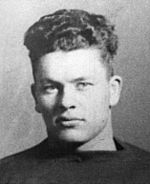
The Green Bay Packers were started on August 11, 1919, by former high school football rivals Earl "Curly" Lambeau and George Whitney Calhoun. Lambeau got money for uniforms from his employer, the Indian Packing Company. He received $500 for uniforms and equipment, as long as the team was named after the company. The Green Bay Packers have played in their original city longer than any other NFL team.
On August 27, 1921, the Packers joined the American Professional Football Association (APFA), which became the National Football League (NFL) a year later. The team faced money problems and lost its franchise for a short time. But Lambeau found new supporters, known as "The Hungry Five," who helped the team get back on track.
Winning NFL Titles (1929, 1930, 1931)
After a close call in 1927, Lambeau's team won their first NFL title in 1929 with an amazing 12–0–1 record. Their defense was very strong, with eight shutouts. Green Bay won the league championship again in 1930 and 1931. They beat teams from New York, Chicago, and other cities. Famous players like Mike Michalske, Johnny (Blood) McNally, Cal Hubbard, and Green Bay native Arnie Herber were on these teams. One impressive achievement was their record of 29 home games without a loss, which is still an NFL record.
More NFL Championships (1936, 1939, 1944)
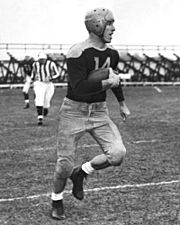
In 1935, Don Hutson joined the Packers from Alabama. He became a powerful offensive player, known for inventing pass patterns. Hutson led the league in receptions for eight seasons and helped the Packers win NFL championships in 1936, 1939, and 1944. He played both offense and defense, even leading the league in interceptions as a safety in 1940. When he retired in 1945, Hutson held 18 NFL records, many of which are still unbroken. In 1951, his number 14 was the first jersey retired by the Packers. He was also one of the first players inducted into the Pro Football Hall of Fame in 1963.
After Hutson retired, the Packers struggled. Curly Lambeau left after the 1949 season. The team had a tough time finding success in the 1950s, even after a new stadium opened in 1957. The 1958 season, under coach Ray "Scooter" McLean, was the worst in Packers history with only one win.
The Vince Lombardi Era (1959–1967)
Vince Lombardi, a former assistant coach for the New York Giants, became the Packers' head coach and general manager on February 2, 1959. This hiring marked the start of an amazing turnaround. Under Lombardi, the Packers became the dominant team of the 1960s, winning five championships in seven years, including the first two Super Bowls. Key players during this time included Bart Starr, Jim Taylor, Paul Hornung, Forrest Gregg, Jerry Kramer, Willie Davis, Henry Jordan, Willie Wood, Ray Nitschke, Dave Robinson, and Herb Adderley.
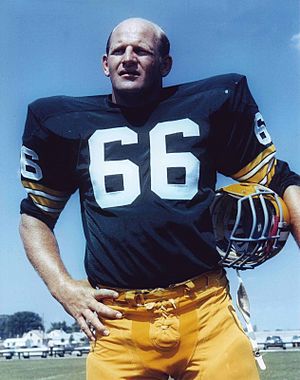
Lombardi's first game as coach was a 9–6 victory over the Chicago Bears on September 27, 1959. The team finished the season with a 7–5 record, their first winning season since 1947. Lombardi was named NFL Coach of the Year.
In 1960, the Packers won the NFL West title and played in the NFL Championship against the Philadelphia Eagles. The Packers lost a close game, 17–13.
NFL Champions (1961, 1962, 1965)
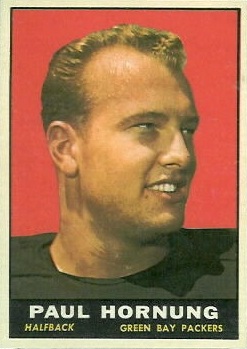
The Packers returned to the NFL Championship game the next season. They faced the New York Giants in Green Bay. The Packers scored 24 points in the second quarter, with Paul Hornung setting a championship record of 19 points. Green Bay won 37–0, earning their first NFL Championship since 1944. This is when Green Bay became known as "Titletown."
The Packers had an incredible 1962 season, starting 10–0 and finishing 13–1. They were featured on the cover of Time magazine. The Packers again defeated the Giants in the championship game, winning 16–7 in New York.
After two seasons without a championship, the Packers returned to the championship game in 1965. They beat the Cleveland Browns 23–12, winning their third NFL Championship under Lombardi and ninth overall.
Super Bowl I Champions (1966)
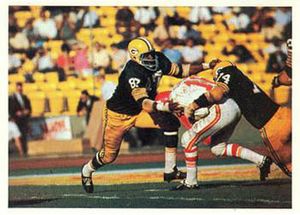
In the 1966 season, the Packers were led by MVP quarterback Bart Starr. They finished 12–2. In the NFL Championship against the Dallas Cowboys, the Packers held on for a 34–27 win. They then dominated the AFL champion Kansas City Chiefs 35–10 in Super Bowl I.
Super Bowl II Champions (1967)
The 1967 season was Lombardi's last as head coach. The NFL Championship game against Dallas became famous as the "Ice Bowl" because of the freezing conditions at Lambeau Field. With only 16 seconds left, Bart Starr scored a touchdown on a quarterback sneak, giving the Packers a 21–17 victory and their third straight NFL Championship. They then won Super Bowl II with a 33–14 victory over the Oakland Raiders. Lombardi stepped down as head coach after this game.
After Lombardi passed away on September 3, 1970, the NFL renamed the Super Bowl trophy the Vince Lombardi Trophy to honor his achievements.
Post-Lombardi Years (1968–1991)
For about 25 years after Lombardi left, the Packers did not have much success. From 1968 to 1991, they only had five winning seasons and made the playoffs twice. This period saw several different head coaches. Poor decisions were made, like trading many draft picks for quarterback John Hadl in 1974, who only played a short time in Green Bay. Another example was drafting Tony Mandarich in 1989 instead of future Hall of Famers like Barry Sanders or Deion Sanders.
To turn things around, Ron Wolf was hired as general manager in 1991, with full control over the team's football decisions.
The Mike Holmgren Era (1992–1998)
In 1992, Wolf hired Mike Holmgren as the Packers' new head coach. Soon after, Wolf acquired quarterback Brett Favre from the Atlanta Falcons. Favre stepped in for an injured quarterback and led a comeback win. He then started every game for Green Bay until the end of the 2007 season, setting a record for consecutive starts by an NFL quarterback.

The Packers finished 9–7 in 1992. In 1993, they signed Reggie White, one of the best defensive players in NFL history. With White, the Packers reached the second round of the playoffs in 1993 and 1994, but lost to the Dallas Cowboys both times. In 1995, the Packers won their division for the first time since 1972. They beat the Atlanta Falcons and San Francisco 49ers in the playoffs before losing to the Dallas Cowboys in the NFC Championship Game.
Super Bowl XXXI Champions (1996)
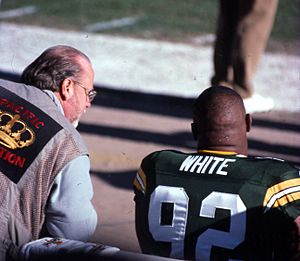
In 1996, the Packers had an amazing season, finishing 13–3. They were ranked number one in offense, defense, and special teams. After easy wins against the San Francisco 49ers and Carolina Panthers, the Packers reached the Super Bowl for the first time in 29 years. In Super Bowl XXXI, Green Bay defeated the New England Patriots 35–21 to win their 12th championship. Desmond Howard was named MVP for his kickoff return touchdown.
The next season, the Packers again had a 13–3 record and won their second straight NFC championship. They beat the Tampa Bay Buccaneers and San Francisco 49ers in the playoffs. However, they lost in an upset to the Denver Broncos in Super Bowl XXXII, 31–24.
In 1998, the Packers went 11–5 and faced the San Francisco 49ers in the playoffs. This was a very close game that the 49ers won in the final seconds. After this season, Mike Holmgren left the Packers, and Reggie White retired.
In 1999, Ray Rhodes was hired as the new head coach, but he was fired after one 8–8 season. In 2000, Wolf replaced Rhodes with Mike Sherman. Sherman had never been a head coach before. The team finished 9–7, and Brett Favre praised the atmosphere Sherman created. After Wolf resigned in 2001, Sherman took on the roles of both general manager and head coach.
From 2001 to 2004, Sherman's teams had good regular seasons, led by Brett Favre and Ahman Green. However, they struggled in the playoffs. In 2003, the Packers lost a home playoff game for the first time since 1933, falling to the Atlanta Falcons. They also lost at home to the Minnesota Vikings two years later. In 2005, Sherman was removed from the general manager position, and Ted Thompson was hired. After a tough 4–12 season, Thompson fired Sherman.
The Mike McCarthy Era (2006–2018)
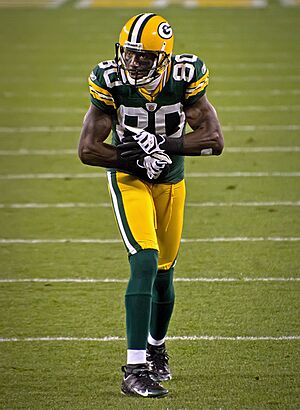
In 2006, Thompson hired Mike McCarthy as head coach. McCarthy had been the Packers' quarterbacks coach in 1999. In his first year, the team finished 8–8.
In 2007, Brett Favre had one of his best seasons, and the Packers finished 13–3, earning a first-round bye in the playoffs. Running back Ryan Grant became a key player. In the divisional playoff round, the Packers beat the Seattle Seahawks 42–20 in a snowstorm. Grant rushed for over 200 yards. On January 20, 2008, Green Bay played in their first NFC Championship Game in 10 years against the New York Giants. They lost 23–20 in overtime. This was Favre's last game as a Packer.

In 2008, Aaron Rodgers, the Packers' 2005 first-round draft pick, became the starting quarterback. Rodgers played well, throwing for over 4,000 yards. However, injuries hurt the defense, and the team finished 6–10. Eight assistant coaches were let go, including defensive coordinator Bob Sanders, who was replaced by Dom Capers.
In 2009, the Packers drafted B. J. Raji and Clay Matthews III. The team finished with an 11–5 record and earned a wild-card playoff spot. Rodgers became the first quarterback in NFL history to throw for at least 4,000 yards in each of his first two seasons as a starter. Cornerback Charles Woodson won NFL Defensive Player of the Year honors. The season ended with an overtime loss to the Arizona Cardinals in the wild-card round, 51–45.
Super Bowl XLV Champions (2010)
The 2010 season was challenging due to many injuries to key players. Despite this, McCarthy's team finished the regular season with a 10–6 record. In Week 17, the Packers secured their playoff spot with a 10–3 victory over the Chicago Bears.
As the No. 6 seed in the NFC playoffs, the Packers went on an impressive run. They beat the Philadelphia 21–16, then defeated the No. 1 seed Atlanta 48–21. They then faced the Chicago Bears in the NFC Championship Game, winning 21–14 to advance to Super Bowl XLV.
On February 6, 2011, the Packers defeated the AFC champion Pittsburgh Steelers 31–25, becoming the first No. 6 seed from the NFC to win a Super Bowl. It was the Packers' first Lombardi Trophy since 1996. Aaron Rodgers was named Super Bowl MVP.
In 2011, the Packers started with 13 straight wins, finishing the season 15–1, a franchise record. Aaron Rodgers was named the NFL's MVP. Despite having home-field advantage, Green Bay lost their first playoff game to the eventual Super Bowl XLVI champion New York Giants, 37–20.
The Packers finished the 2012 season 11–5 and won their division. They beat the Minnesota Vikings in the wild-card round but lost to the San Francisco 49ers 45–31 in the divisional playoffs.
In 2013, Aaron Rodgers missed six games due to a broken collarbone. Despite a 7–7–1 record, the Packers won their division by beating the Bears in the final game. They lost to the 49ers 20–23 in the playoffs.
The Packers recorded their 700th victory in 2014 against the Bears. They went undefeated at home and led the league in scoring. McCarthy passed Vince Lombardi for all-time wins for the Packers. The team finished 12–4, winning their division for the fourth straight year. They beat the Cowboys in the divisional round but lost to the Seattle Seahawks 28–22 in overtime in the NFC Championship. Rodgers won his second MVP award.
In 2015, wide receiver Jordy Nelson suffered a season-ending injury. The Packers started 6–0 but then lost four of their next five games. In a game against the Detroit Lions, Rodgers threw a 61-yard "Hail Mary" touchdown pass to Richard Rodgers to win the game. The Packers finished 10–6 and lost to the Arizona Cardinals 26–20 in overtime in the divisional playoffs.
After a 4–6 start in 2017, the Packers won six straight games to finish 10–6. They beat the New York Giants and Dallas Cowboys in the playoffs but lost to the Atlanta Falcons in the NFC Championship Game.
In 2017, Aaron Rodgers broke his collarbone in Week 6 and missed most of the season. The Packers finished 7–9, missing the playoffs for the first time since 2008. In 2018, the Packers again missed the playoffs with a 6–9–1 record. McCarthy was released as head coach after Week 13.
The Matt LaFleur Era (2019–present)
Under first-year head coach Matt LaFleur, the Packers started the 2019 season by defeating the Chicago Bears. The Packers returned to the playoffs, finishing 13–3 and securing a first-round bye. They defeated the Seattle Seahawks 28–23 in the Divisional Round but lost 37–20 to the San Francisco 49ers in the NFC Championship game.
In 2020, the Green Bay Packers won the NFC North Division again and earned the top seed in the NFC. They defeated the Los Angeles Rams 32–18 in the Divisional Round but lost to the Tampa Bay Buccaneers in the NFC Championship. Aaron Rodgers won his third MVP award that season.
In 2021, they clinched the top seed in the NFC again with a 13–4 record. However, they lost 13–10 to the 49ers in the Divisional Round. Matt LaFleur became the first coach to have three straight 13-win seasons. Aaron Rodgers won his fourth MVP award, second only to Peyton Manning.
In the 2022 season, the Packers struggled and missed the playoffs, finishing with an 8–9 record.
The 2023 season was the first without longtime quarterback Aaron Rodgers, who was traded. Jordan Love took over as starting quarterback. The team finished 9–8, securing a playoff spot. The Packers defeated the Dallas Cowboys 48–32 in their Wild-Card game, becoming the first 7th seed team to win a playoff game. They then lost to the San Francisco 49ers 24–21 in the Divisional Round.
In 2024, the Packers finished 11–6, thanks to new players like running back Josh Jacobs and safety Xavier McKinney. Backup quarterback Malik Willis also won games when Jordan Love was injured. Despite their good record, they finished third in their division. They earned the 7th seed in the NFC playoffs but lost to the Philadelphia Eagles 22–10 in the Wild-Card matchup.
Community Ownership
The Packers are the only community-owned team in North American major professional sports. Instead of being owned by one person or company, they are owned by over 537,000 stockholders as of 2022. No one person can own more than 200,000 shares. This community ownership is why the team has stayed in Green Bay for over a century, even though it's the smallest market in professional sports.
Green Bay has a population of only about 107,395 people. However, the team has a large fan base across Wisconsin and the Midwest. This is partly because they used to play some home games in Milwaukee until 1995.
Since 1923, there have been six stock sales to help fund the team. The most recent was in November 2021. The original rules from 1923 stated that if the team was ever sold, any money left over would go to the American Legion to build a soldier's memorial. This rule was to make sure the team would never leave Green Bay. In 1997, shareholders voted to change the beneficiary to the Green Bay Packers Foundation, which supports many charities in Wisconsin.
A share of Packers stock is different from regular stock. It doesn't give you a share of the company's profits, doesn't pay dividends, can't be traded, and doesn't give you special rights to buy season tickets. Shareholders get voting rights, an invitation to the annual meeting, and a chance to buy special merchandise. Shares cannot be resold except back to the team for a small price.
The Packers are the only NFL team with this type of ownership. The NFL has rules about how many owners a team can have, but the Packers were allowed to keep their unique structure because it was in place before the rules changed. As a publicly owned nonprofit, the Packers are also the only major American sports team to share their financial reports every year.
Board of Directors
Green Bay Packers, Inc. is managed by a seven-member executive committee. This committee is chosen from a 45-member board of directors. Only the president of the committee is paid. Their jobs include managing the company, approving big spending, setting policies, and checking how well the management is doing.
The team's elected president usually represents the Packers at NFL owner's meetings.
Green Bay Packers Foundation
The Green Bay Packers Foundation was created in December 1986. It helps various activities and programs related to education, community projects, health services, human services, and youth programs.
Fan Base
The Packers have incredibly loyal fans. Every game played in Green Bay, including preseason, regular season, and playoffs, has been sold out since 1960. Even though Green Bay is the smallest local TV market, the team is consistently one of the most popular in the NFL. They also have one of the longest waiting lists for season tickets in professional sports, with 140,000 names. The average wait is said to be over 30 years. Because of this, season tickets are often passed down in families, and newborns are sometimes put on the waiting list.
Packers fans are often called cheeseheads. This nickname for Wisconsin residents comes from the state's large cheese production. It started as an insult but became a source of pride, especially since 1994. Bright orange triangular cheesehead hats are a common sight wherever the team plays.
During training camp in the summer, young Packers fans can bring their bikes and have their favorite players ride them from the locker room to practice. This tradition started around 1957.
The team holds an annual scrimmage called Family Night at Lambeau Field. In 2005, over 62,000 fans attended. In August 2008, ESPN.com ranked Packers fans as the second-best in the NFL.
Team Branding
Nickname Origin
When team founder Curly Lambeau needed money for uniforms, he asked his employer, the Indian Packing Company. He received $500 in exchange for naming the team after the company. Early newspaper articles called them "the Indians," but "Packers" quickly became the team's name.
In 1920, Indian Packing was bought by the Acme Packing Company. Acme continued to support the team, and their jerseys in the first NFL season had "ACME PACKERS" on them.
Team Colors
Lambeau, who went to the University of Notre Dame, used their navy blue and gold team colors for the Packers. Because of this, the early Packers were sometimes called the "Bays" or the "Blues."
By 1950, Green Bay changed navy blue to kelly green but kept a lighter shade of athletic gold. Navy blue was a secondary color but was later dropped. In 1958, kelly green was replaced by a darker hunter green. These two colors, along with athletic gold, have been the team colors ever since. The team's current uniforms, with forest green or white jerseys and metallic gold pants, were adopted after Vince Lombardi arrived in 1959.
Team Logo
In 1951, the team started wearing metallic gold plastic helmets. The oval "G" logo was added in 1961 when Lombardi asked for a new logo. His assistant, John Gordon, designed the football-shaped letter "G," which Lombardi approved. The Packers own the trademark for the "G" logo. They have allowed other organizations, like the University of Georgia and Grambling State University, to use a similar logo.
Uniform Variations
While some NFL teams wear white jerseys at home early in the season to stay cool, the Packers have only done this twice. In 2016, the Packers introduced their Color Rush uniform, which is all white. This uniform has been worn five times, mostly at home. In 2024, the all-white Color Rush uniform was paired with a new alternate white helmet.
In 2010, the Packers wore a throwback jersey from their 1929 championship season. It was navy blue with a gold circle and navy numbers. In 2015, they changed to a navy blue throwback from 1937 to 1949, with gold shoulders and numbers. In 2021, the Packers changed their throwback uniforms again to an all-green design, similar to those worn from 1950 to 1953.
When the NFL switched uniform suppliers to Nike in 2012, the Packers refused any changes to their uniform design, keeping their traditional look.
Team Rivalries
Divisional Rivals
Chicago Bears
The Packers and Chicago Bears have been rivals since 1920, making it one of the oldest rivalries in the NFL. The Packers currently lead the series 107–95–6. They have met twice in the playoffs. The Bears won in 1941, and the Packers won in 2011 on their way to a Super Bowl win. The rivalry has featured notable moments, like the first player ejections in NFL history in 1924. As of the 2024 season, the Packers lead the all-time series 108–96–6.
Minnesota Vikings
The rivalry between the Packers and Minnesota Vikings started in 1961. It is known for its intense matchups. Events like Randy Moss's actions in a playoff game and former Packer great Brett Favre joining the Vikings have added to the rivalry. The Packers lead the all-time series 66–60–3.
Detroit Lions
The Packers' rivalry with the Detroit Lions is another old matchup in the NFL. They first met in 1930 when the Lions were the Portsmouth Spartans. The teams have been division rivals since 1933 and have played at least twice a season since 1932. The Packers lead the series 106–78–7 as of the end of the 2024 season, making them the first team in NFL history to record 100 wins over an opponent.
Conference Rivals
Dallas Cowboys
The rivalry between the Packers and Dallas Cowboys has led to several famous games, including the "Ice Bowl." During the Brett Favre era, the Cowboys often won against the Packers. However, in the Aaron Rodgers era (2008–2022), the Packers have mostly won against the Cowboys. The Packers lead the all-time series 22–17. In the playoffs, the Packers lead 5–4, with their most recent win in January 2024.
San Francisco 49ers
The rivalry between the Packers and the San Francisco 49ers became intense in the 1990s, with the teams playing each other in four straight playoff games. The Packers won four of five playoff games against the 49ers with Brett Favre as quarterback. Since 2012, the 49ers have beaten the Aaron Rodgers-led Packers four times in the playoffs. The Packers currently lead the series 39–34–1, but the 49ers lead 6–4 in postseason meetings.
Seattle Seahawks
After Seattle moved to the NFC in 2002, the Packers and Seattle Seahawks have played many intense playoff games. Notable moments include a game in 2003 where Seahawks quarterback Matt Hasselbeck threw a game-losing interception in overtime, and Russell Wilson leading Seattle to a comeback win in 2014 despite throwing four interceptions. As of the 2023 season, the Packers lead the all-time series 16–9.
New York Giants
The series between the Packers and New York Giants is one of the oldest regular matchups in the league, starting in 1928. The Packers lead the all-time series 34–28–2 and the postseason series 5–3.
Tampa Bay Buccaneers
The Tampa Bay Buccaneers and Packers were division rivals from 1977 to 2002. They have played several notable games, including a "Snow Bowl" game in 1985 and the NFC Championship Game in 2021. As of the 2024 season, the Packers lead the series 34–24–1.
Stadium History
After playing in Bellevue Park and Hagemeister Park in their early years, the Packers played home games in City Stadium from 1925 to 1956. They won their first six NFL championships there.
By the 1950s, the old stadium was considered outdated. The NFL threatened to move the team to Milwaukee unless they got a better stadium. The city built a new 32,150-seat City Stadium, which opened in 1957. It was the first stadium built only for an NFL team. In 1965, it was renamed Lambeau Field to honor Curly Lambeau.
Lambeau Field was expanded many times and now seats 72,928 people. Even with this large capacity, all Packers games have been sold out since 1960. There is a waiting list of about 86,000 names for season tickets.
The Packers played some home games in Milwaukee from 1933 to 1994. This helped them connect with fans in Milwaukee and draw larger crowds. By 1994, improvements at Lambeau Field meant the Packers could play all their home games in Green Bay. Former season ticket holders for the Milwaukee games still get special access to certain games at Lambeau Field through the "Gold Package" plan.
The Packers have three practice facilities near Lambeau Field: the Don Hutson Center (indoor), Ray Nitschke Field (outdoor with artificial turf), and Clarke Hinkle Field (outdoor with natural grass).
The Packers Pro Shop is the team's official retail store, located at Lambeau Field.
Statistics and Records
All-Time Packers Leaders
| All-Time Packers leaders | |||
|---|---|---|---|
| Leader | Player | Record Number | Years on Packers |
| Passing | Brett Favre | 61,655 passing yards | 1992–2007 |
| Rushing | Ahman Green | 8,322 rushing yards | 2000–2006; 2009 |
| Receiving | Donald Driver | 10,137 receiving yards | 1999–2012 |
| Coaching wins | Curly Lambeau | 209 wins | 1919–1949 |
Championships
The Packers have won a record 13 league championships. They are the only team to win three NFL titles in a row, doing it twice: from 1929 to 1931 under Lambeau, and from 1965 to 1967 under Lombardi.
Super Bowl Championships
The NFL started holding the Super Bowl in 1966. The Packers have won four Super Bowls:
- Super Bowl I (1966)
- Super Bowl II (1967)
- Super Bowl XXXI (1996)
- Super Bowl XLV (2010)
NFL Championships (Pre-Super Bowl Era)
Before the Super Bowl, the NFL held a championship game from 1933 to 1969. The Packers won eight NFL Championship Games:
- 1936
- 1939
- 1944
- 1961
- 1962
- 1965
- 1966
- 1967
NFC Championships
The Packers have won three NFC Championship Games since the AFL–NFL merger in 1970:
- 1996
- 1997
- 2010
NFL Championships by Standings
From 1920 to 1932, the NFL championship was decided by league standings. The Packers won three championships this way:
- 1929
- 1930
- 1931
Division Championships
The Packers have won 21 divisional championships.
Notable Players
Current Roster
|
Green Bay Packers roster
|
|||||||||
|---|---|---|---|---|---|---|---|---|---|
Quarterbacks
Running backs
Wide receivers
Tight ends
|
Offensive linemen
Defensive linemen
|
Linebackers
Defensive backs
Special teams
|
Reserve lists
→ AFC rosters → NFC rosters |
||||||
Pro Football Hall of Fame Members
The Packers have the second-highest number of members in the Pro Football Hall of Fame with 30 players, 25 of whom were inducted as Packers.
| Green Bay Packers Pro Football Hall of Famers | |||||||||
|---|---|---|---|---|---|---|---|---|---|
| Players | |||||||||
| No. | Name | Positions | Seasons | Inducted | No. | Name | Positions | Seasons | Inducted |
| 26 | Herb Adderley | CB | 1961–1969 | 1980 | 64 | Jerry Kramer | G | 1958–1968 | 2018 |
| 36 | LeRoy Butler | S | 1990–2001 | 2022 | 20 | Earl (Curly) Lambeau | HB Coach |
1919–1929 1930–1949 |
1963 |
| 3 | Tony Canadeo | HB | 1941–1944 1946–1952 |
1974 | 80 | James Lofton | WR | 1978–1986 | 2003 |
| 87 | Willie Davis | DE | 1960–1969 | 1981 | 24 | Johnny "Blood" McNally | HB | 1929–1933 1935–1936 |
1963 |
| 44 | Bobby Dillon | S | 1952–1959 | 2020 | 2 | Mike Michalske | OG | 1929–1935 1937 |
1964 |
| 4 | Brett Favre | QB | 1992–2007 | 2016 | 66 | Ray Nitschke | LB | 1958–1972 | 1978 |
| 75 | Forrest Gregg | OT | 1956 1958–1970 |
1977 | 51 | Jim Ringo | C | 1953–1963 | 1981 |
| 56 | Ted Hendricks | LB | 1974 | 1990 | 89 | Dave Robinson | LB | 1963–1972 | 2013 |
| 38 | Arnie Herber | QB | 1930–1940 | 1966 | 84 | Sterling Sharpe | WR | 1988–1994 | 2025 |
| 30 | Clarke Hinkle | FB | 1932–1941 | 1964 | 15 | Bart Starr | QB | 1956–1971 | 1977 |
| 5 | Paul Hornung | HB | 1956–1962 1964–1966 |
1986 | 31 | Jim Taylor | FB | 1958–1966 | 1976 |
| 36 | Cal Hubbard | OT | 1929–1933 1935 |
1963 | 92 | Reggie White | DE | 1993–1998 | 2006 |
| 14 | Don Hutson | E | 1935–1945 | 1963 | 24 | Willie Wood | S | 1960–1971 | 1989 |
| 74 | Henry Jordan | DT | 1959–1969 | 1995 | 21 | Charles Woodson | CB | 2006–2012 | 2021 |
| Coaches and Executives | |||||||||
| Name | Positions | Seasons | Inducted | ||||||
| Vince Lombardi | Coach | 1959–1967 | 1971 | ||||||
| Ron Wolf | General manager | 1991–2001 | 2015 | ||||||
Wisconsin Athletic Hall of Fame
Many Packers players and coaches are also in the Wisconsin Athletic Hall of Fame. Ron Wolf was inducted in 2018.
Retired Numbers
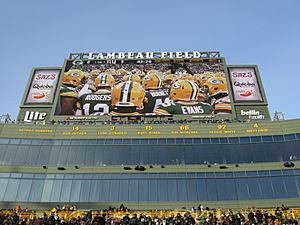
The Packers have officially retired six jersey numbers. All six players are in the Pro Football Hall of Fame. Their numbers and names are shown on the green wall of Lambeau Field's north end zone and in the Lambeau Field Atrium.
 |
 |
 |
 |
 |
 |
| Tony Canadeo HB, 1941–1944, 1946–1952 Retired 1952 |
Brett Favre QB, 1992–2007 Retired 2015 |
Don Hutson WR, 1935–1945 Retired 1951 |
Bart Starr QB, 1956–71 Retired 1973 |
Ray Nitschke LB, 1958–1972 Retired 1983 |
Reggie White DE, 1993–1998 Retired 2005 |
Green Bay Packers Hall of Fame
The Green Bay Packers Hall of Fame was the first hall of fame built to honor a single professional American football team. It was co-founded in 1966. As of 2019, 162 people have been inducted.
Notable Coaches
Current Staff
|
→ Coaching staff |
|||||
Head Coaches
| Name | Tenure | Record | Titles | ||
|---|---|---|---|---|---|
| W | L | T | |||
| Earl (Curly) Lambeau | 1919–1949 | 231 | 108 | 21 | 6 |
| Gene Ronzani | 1950–1953 | 14 | 31 | 1 | |
| Hugh Devore* | 1953 | 0 | 2 | 0 | |
| Ray (Scooter) McLean* | |||||
| Lisle Blackbourn | 1954–1957 | 17 | 31 | 0 | |
| Ray (Scooter) McLean | 1958 | 1 | 10 | 1 | |
| Vince Lombardi | 1959–1967 | 98 | 30 | 4 | 5 |
| Phil Bengtson | 1968–1970 | 20 | 21 | 1 | |
| Dan Devine | 1971–1974 | 25 | 28 | 4 | |
| Bart Starr | 1975–1983 | 53 | 77 | 3 | |
| Forrest Gregg | 1984–1987 | 25 | 37 | 1 | |
| Lindy Infante | 1988–1991 | 24 | 40 | 0 | |
| Mike Holmgren | 1992–1998 | 73 | 36 | 0 | 1 |
| Ray Rhodes | 1999 | 8 | 8 | 0 | |
| Mike Sherman | 2000–2005 | 56 | 39 | 0 | |
| Mike McCarthy | 2006–2018 | 125 | 77 | 2 | 1 |
| Joe Philbin* | 2018 | 2 | 2 | 0 | |
| Matt LaFleur | 2019–present | 67 | 33 | 0 | |
*Interim head coaches
Media
The Packers are unique because their market covers two areas: Green Bay and Milwaukee. Packers games have not been blacked out locally since 1972 because of strong attendance and popularity. Every Packers home game has been sold out since 1960.
Radio
The main radio station for the Packers Radio Network is WRNW (97.3) in Milwaukee. Previously, WTMJ in Milwaukee broadcast the games since 1929. Games also air in Green Bay on WTAQ (1360/97.5) and WIXX-FM (101.1), and WYDR (94.3) in Appleton.
Wayne Larrivee is the play-by-play announcer, and Larry McCarren is the color analyst. When the Packers are sure to win, Larrivee often says, "And there is your dagger!"
Television
TV rights for preseason games not shown nationally are held by WGBA-TV (channel 26) in Green Bay and WTMJ-TV (channel 4) in Milwaukee. These broadcasts are sent to 19 other TV stations in several states.
The team's annual Lambeau scrimmage, called Packers Family Night, is broadcast by the Packers Television Network. Preseason TV games are announced by Kevin Harlan and Rich Gannon. Regular season and postseason games not on a national network are also shown on local stations in Green Bay and Milwaukee.
See also
 In Spanish: Green Bay Packers para niños
In Spanish: Green Bay Packers para niños



